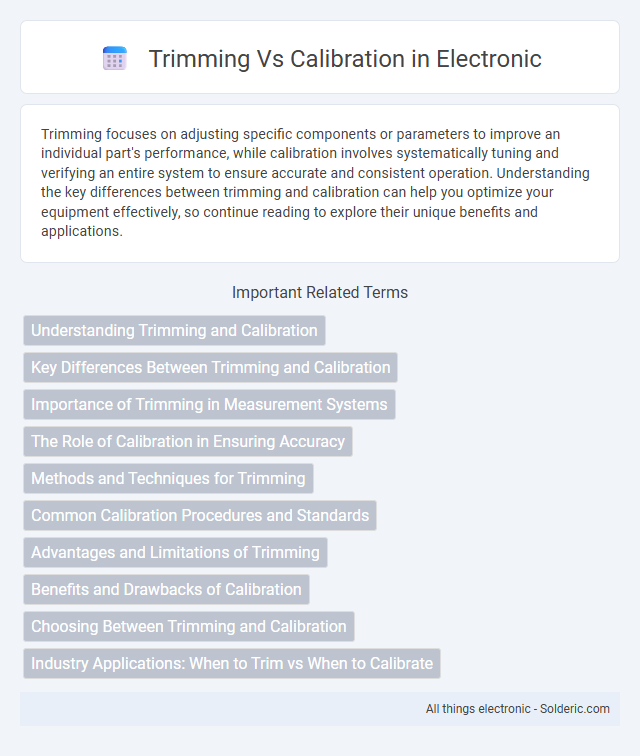Trimming focuses on adjusting specific components or parameters to improve an individual part's performance, while calibration involves systematically tuning and verifying an entire system to ensure accurate and consistent operation. Understanding the key differences between trimming and calibration can help you optimize your equipment effectively, so continue reading to explore their unique benefits and applications.
Comparison Table
| Aspect | Trimming | Calibration |
|---|---|---|
| Definition | Adjusting device parameters to meet specifications. | Comparing and adjusting instrument accuracy against a standard. |
| Purpose | Fine-tune performance settings. | Ensure measurement correctness and precision. |
| Process | Modification of internal components or software. | Measurement versus reference standard; adjustments as needed. |
| Frequency | Usually once during manufacturing or repair. | Repeated periodically based on usage or regulation. |
| Outcome | Device adjusted to desired operational parameters. | Instrument validated and certified for accuracy. |
| Examples | Trimming a resistor, adjusting amplifier gain. | Calibrating a thermometer, weighing scale calibration. |
Understanding Trimming and Calibration
Trimming involves making fine adjustments to electronic components to improve circuit performance by modifying parameters such as resistance or capacitance. Calibration ensures measurement accuracy by aligning instruments or sensors with known standards, correcting systematic errors. Both processes are essential for maintaining device precision and reliability in various industrial and scientific applications.
Key Differences Between Trimming and Calibration
Trimming involves making fine adjustments to hardware components to improve accuracy and performance by setting initial reference points, while calibration adjusts the entire measurement system to align outputs with known standards. Calibration requires traceable reference instruments and is typically performed periodically to ensure ongoing precision, whereas trimming is usually a one-time process during manufacturing. Your choice between trimming and calibration depends on whether you need permanent component correction or regular system verification.
Importance of Trimming in Measurement Systems
Trimming in measurement systems is crucial for enhancing accuracy by minimizing offset errors and ensuring sensor outputs align closely with true values. Precise trimming procedures improve system stability and reliability, preventing drift that can lead to measurement inaccuracies over time. Properly trimmed components contribute to the overall performance of calibration, reducing the need for frequent recalibration and extending the operational lifespan of measurement devices.
The Role of Calibration in Ensuring Accuracy
Calibration is essential for maintaining the accuracy of measurement instruments by adjusting them to match a known standard or reference point. Trimming involves minor adjustments to optimize performance, but it does not replace the comprehensive process of calibration required for precision. Regular calibration ensures reliability and consistency in data, minimizing errors caused by drift, wear, or environmental changes.
Methods and Techniques for Trimming
Trimming methods typically involve precise physical adjustments such as laser trimming, mechanical cutting, or electrical fusing to fine-tune component parameters during manufacturing. Calibration techniques focus on software-based tuning or external measurement feedback to ensure devices operate within specified tolerances, often through iterative adjustments and compensation algorithms. Your choice between trimming and calibration depends on the required accuracy, production scale, and whether permanent or adjustable modifications are preferred.
Common Calibration Procedures and Standards
Common calibration procedures involve comparing measurement tools against known standards to ensure accuracy, such as ISO 17025 accreditation or ASTM protocols. Trimming adjusts device parameters within the calibration process to fine-tune performance, often using reference standards like NIST or traceable artifacts. Your equipment's reliability depends on adherence to these recognized calibration standards and systematic trimming techniques for optimal precision.
Advantages and Limitations of Trimming
Trimming offers precise, cost-effective adjustments to improve device performance by removing excess material or modifying components, enhancing overall accuracy with minimal downtime. Its main advantage lies in fine-tuning equipment without requiring extensive recalibration, saving time and expenses in production environments. However, trimming may lead to irreversible changes, limiting future flexibility and sometimes causing inconsistent results if not performed with strict control and expertise.
Benefits and Drawbacks of Calibration
Calibration ensures accurate and consistent performance of instruments by adjusting them to meet predefined standards, which enhances reliability and precision in measurement-based applications. The benefits of calibration include improved accuracy, reduced error rates, and compliance with industry regulations, making it essential in fields like manufacturing, healthcare, and environmental monitoring. However, calibration requires specialized equipment, can be time-consuming, and may incur costs, which are key drawbacks compared to simpler maintenance processes like trimming.
Choosing Between Trimming and Calibration
Selecting between trimming and calibration depends on the desired accuracy and application context. Trimming offers a one-time, permanent adjustment to optimize device performance during manufacturing, ideal for stable conditions and mass production. Calibration involves periodic fine-tuning to maintain precision over time, crucial for environments with variable factors and critical measurement requirements.
Industry Applications: When to Trim vs When to Calibrate
Trimming is ideal for fine-tuning sensors and devices during manufacturing to meet strict tolerances in industries like automotive and aerospace, where consistent performance is crucial. Calibration is essential for periodic verification and adjustment of equipment in medical, laboratory, and industrial settings to ensure ongoing accuracy and compliance with regulatory standards. Choosing trimming or calibration depends on whether the need is initial precision adjustment or routine performance validation.
trimming vs calibration Infographic

 solderic.com
solderic.com